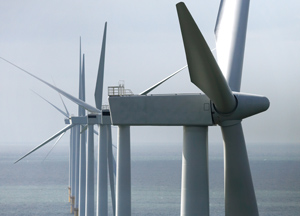PREMIUM AEROTEC
Takeover of EADS composite processing in Lemwerder / Cooperation with SGL Group
 The Burbo Bank wind farm in the UK (Photo: Siemens) |
At the beginning of December 2009, the European Aeronautic Defence and Space Company (EADS, German offices: EADS Deutschland, Munich; www.eads.com), Premium Aerotec (Augsburg / Germany; www.premium-aerotec.com) and the SGL Group (Wiesbaden / Germany; www.sglcarbon.com) put the finishing touches on their future plans for the EADS facility in Lemwerder. Premium Aerotec will take over the operative business of composite manufacturer Aircraft Services Lemwerder (ASL) – as it did with the plants in Varel, Nordenham and Augsburg (see Plasteurope.com of 08.09.2008). SGL’s subsidiary SGL Rotec, also located in Lemwerder, will buy both the estate and the buildings owned by EADS. The transfer will affect about 330 employees, who will receive offers to work at other EADS sites or at SGL Rotec itself, an EADS spokesman said.
EADS produces composite airplane parts in Lemwerder, including the body parts of the Airbus “A 400M” military transport plane, the rear end of the “Eurofighter” as well as spare parts for the multipurpose “Tornado” plane and the “Transall C-160” transport plane. However, sproduction of the latter two is being phased out, which partly explains the sale. EADS said that although production of A 400M parts would continue, it remained unclear at which site. ASL’s latest balance sheet showed positive figures, with sales of about EUR 40m.
SGL Rotec’s 170 employees produce rotor blades for wind power plants, a field where ASL is supposed to become active in the future as well. “We hope this will give the Lemwerder site a perspective for the future,” an EADS spokesperson said. In mid- 2008, SGL acquired 51% of Abeking & Rasmussen Rotec (A&R Rotec, Lemwerder / Germany; www.ar-rotec.de), a subsidiary of Abeking & Rasmussen Schiffs- und Yachtwerft, creating SGL Rotec as a result. With a predicted sales volume of EUR 50m in 2008, SGL Rotec is one of the few independent rotor blade manufacturers – like the much bigger LM Glasfiber (Lunderskov / Denmark; www.lmglasfiber.com). A few weeks ago, LM Glasfiber, which recorded sales of about EUR 900m in 2008, announced that, due to declining demand in Europe, it would shift capacity toward its plants in China.
Most manufacturers of wind power plants produce their own rotor blades, including Vestas (Denmark), Gamesa (Spain), Enercon (Germany) and Siemens (Germany). While glass fibres continue to be the most accepted means of reinforcement, SGL obviously plans to spur the further development of the more expensive carbon fibres. Elsewhere, too, SGL’s integrated processing structure centred on carbon fibres is setting itself apart from the norm. The company recently created a 51:49 joint venture with BMW to produce carbon fibre for both exterior and interior car parts – see Plasteurope.com of 02.11.2009.
EADS produces composite airplane parts in Lemwerder, including the body parts of the Airbus “A 400M” military transport plane, the rear end of the “Eurofighter” as well as spare parts for the multipurpose “Tornado” plane and the “Transall C-160” transport plane. However, sproduction of the latter two is being phased out, which partly explains the sale. EADS said that although production of A 400M parts would continue, it remained unclear at which site. ASL’s latest balance sheet showed positive figures, with sales of about EUR 40m.
SGL Rotec’s 170 employees produce rotor blades for wind power plants, a field where ASL is supposed to become active in the future as well. “We hope this will give the Lemwerder site a perspective for the future,” an EADS spokesperson said. In mid- 2008, SGL acquired 51% of Abeking & Rasmussen Rotec (A&R Rotec, Lemwerder / Germany; www.ar-rotec.de), a subsidiary of Abeking & Rasmussen Schiffs- und Yachtwerft, creating SGL Rotec as a result. With a predicted sales volume of EUR 50m in 2008, SGL Rotec is one of the few independent rotor blade manufacturers – like the much bigger LM Glasfiber (Lunderskov / Denmark; www.lmglasfiber.com). A few weeks ago, LM Glasfiber, which recorded sales of about EUR 900m in 2008, announced that, due to declining demand in Europe, it would shift capacity toward its plants in China.
Most manufacturers of wind power plants produce their own rotor blades, including Vestas (Denmark), Gamesa (Spain), Enercon (Germany) and Siemens (Germany). While glass fibres continue to be the most accepted means of reinforcement, SGL obviously plans to spur the further development of the more expensive carbon fibres. Elsewhere, too, SGL’s integrated processing structure centred on carbon fibres is setting itself apart from the norm. The company recently created a 51:49 joint venture with BMW to produce carbon fibre for both exterior and interior car parts – see Plasteurope.com of 02.11.2009.
16.12.2009 Plasteurope.com [215084]
Published on 16.12.2009

 German version of this article...
German version of this article...